

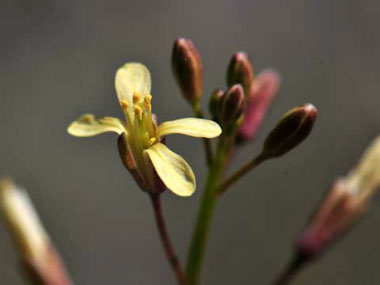
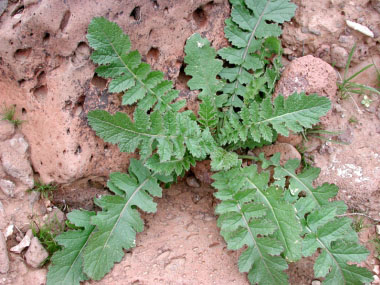
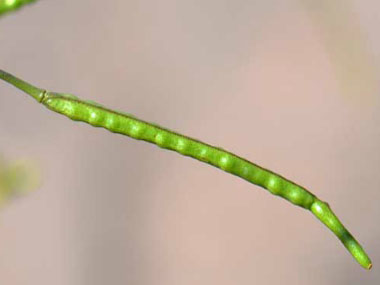
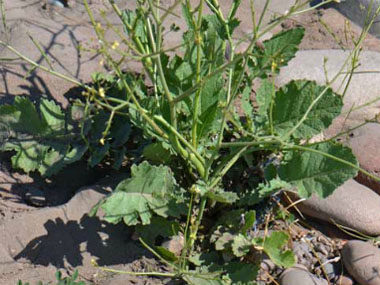
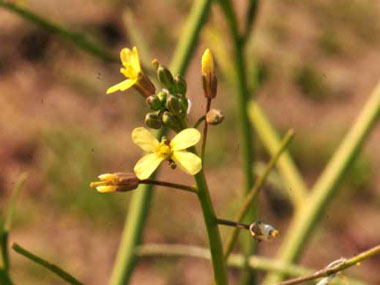
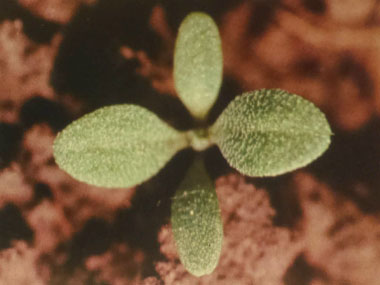
To support our efforts please browse our store (books with health benefits, etc.).
Asian Mustard is a widespread annual, native plant to Africa, Asia and Europe. The species has become widely spread and naturalised in southwest USA, Australia and New Zealand. This plant is in the Brassicaceae family as it also known as the African Mustard, Desert Mustard, Moroccan Mustard, and Sahara Mustard. Interestingly, a well-developed plant can produce up to 16,000 seeds. Mature plants can dry up and break off forming a tumbleweed that could be mistaken for Russian thistle.
Distinguishing Features
This rapid growing plant has almost leafless stems that grow about 60cm from the plant creating a bush-like appearance. Mature plants can dry up and break off forming a tumbleweed that could be mistaken for Russian thistle. It doesn't take much water for this plant to sprout.
Flowers
This plant flowers early in the growing season. The small, dull yellow flowers are inconspicuous compared to most other true mustards. Each flower has four petals and four sepals. It has six stamens, 4 long, 2 short. The fruit is a long rounded capsule, narrowed between seeds; seeds drop into the soil and have the ability to survive fire.
 Fields
of Nutrition has medicinal benefits and vitamin/mineral content of Asian Mustard.
Fields
of Nutrition has medicinal benefits and vitamin/mineral content of Asian Mustard.
Leaves
Asian mustard plants have basal rosetted leaves. Leaf petioles are slightly hairy. Leaves are pinnately lobed, serrate-dentate, with lateral lobe pairs (4 to 10). The base is tapered, not lobed.
Height
Asian mustard shows variability in size depending on the availability of soil moisture. Drought-stressed plants can reproduce with leaves as small as 8cm long and on sandy soils with sufficient moisture leaves have known to grow to more than 50cm long, giving the plant a 1m spread. Depending on location, this annual plant can grow anywhere from 10 to 100cm tall.
Habitat
Asian mustard prefers sandy soil, and is known to live in unfavourable environmental conditions where no other plants can grow.This plant is known to also grow in fields, along roadsides, rocky hillsides, poor quality soils, deserts, and along crop fields.
Edible Parts
This mustard plant is an edible leafy green formerly consumed by North African populations. Nowadays, this plant has been somewhat neglected as a valuable source of food. Leaves and young shoots can be consumed.
Other Name
African Mustard.
Similar Plants
Winter Survival Food Handbook

PDF Plant Magazines
Types of Wild Food
Geographic Zones Seasons
Disclaimer
EdibleWildFood.com is informational in nature. While we strive to be 100% accurate, it is solely up to the reader to ensure proper plant identification. Some wild plants are poisonous or can have serious adverse health effects.
We are not health professionals, medical doctors, nor are we nutritionists. It is up to the reader to verify nutritional information and health benefits with qualified professionals for all edible plants listed in this web site. Please click here for more information.
Why Edible Wild Food?
- Food costs are rising
- Free, wild food is readily abundant
- Wild food adds nutrition to your diet
- Wild food can help treat various medical conditions





